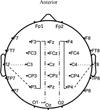Brief Report: Reduced Temporal-Central EEG Alpha Coherence During Joint Attention Perception in Adolescents with Autism Spectrum Disorder
- PMID: 26659813
- PMCID: PMC5030110
- DOI: 10.1007/s10803-015-2667-3
Brief Report: Reduced Temporal-Central EEG Alpha Coherence During Joint Attention Perception in Adolescents with Autism Spectrum Disorder
Abstract
Although prior studies have demonstrated reduced resting state EEG coherence in adults with autism spectrum disorder (ASD), no studies have explored the nature of EEG coherence during joint attention. We examined the EEG coherence of the joint attention network in adolescents with and without ASD during congruent and incongruent joint attention perception and an eyes-open resting condition. Across conditions, adolescents with ASD showed reduced right hemisphere temporal-central alpha coherence compared to typically developing adolescents. Greater right temporal-central alpha coherence during joint attention was positively associated with social cognitive performance in typical development but not in ASD. These results suggest that, in addition to a resting state, EEG coherence during joint attention perception is reduced in ASD.
Keywords: Adolescent autistic brain; Adolescents with ASD; Brain connectivity; Cortical connectivity; EEG coherence; Joint attention; Joint attention network connectivity; Neurocognitive features of joint attention in ASD.
Conflict of interest statement
The authors declare that they have no conflict of interest.
Figures




Similar articles
-
Changes in Electroencephalogram Coherence in Adolescents With Autism Spectrum Disorder After a Social Skills Intervention.Autism Res. 2021 Apr;14(4):787-803. doi: 10.1002/aur.2459. Epub 2021 Jan 4. Autism Res. 2021. PMID: 33398936 Clinical Trial.
-
Functional connectivity in ASD: Atypical pathways in brain networks supporting action observation and joint attention.Brain Res. 2019 Mar 1;1706:157-165. doi: 10.1016/j.brainres.2018.10.029. Epub 2018 Oct 27. Brain Res. 2019. PMID: 30392771
-
EEG theta and beta power spectra in adolescents with ADHD versus adolescents with ASD + ADHD.Eur Child Adolesc Psychiatry. 2015 Aug;24(8):873-86. doi: 10.1007/s00787-014-0632-x. Epub 2014 Nov 6. Eur Child Adolesc Psychiatry. 2015. PMID: 25374034
-
A systematic review and meta-regression analysis of social functioning correlates in autism and typical development.Autism Res. 2019 Feb;12(2):152-175. doi: 10.1002/aur.2055. Epub 2018 Dec 21. Autism Res. 2019. PMID: 30575308
-
EEG Biomarkers for Autism: Rational, Support, and the Qualification Process.Adv Neurobiol. 2024;40:545-576. doi: 10.1007/978-3-031-69491-2_19. Adv Neurobiol. 2024. PMID: 39562457 Review.
Cited by
-
EEG resting-state functional connectivity: evidence for an imbalance of external/internal information integration in autism.J Neurodev Disord. 2022 Aug 27;14(1):47. doi: 10.1186/s11689-022-09456-8. J Neurodev Disord. 2022. PMID: 36030210 Free PMC article.
-
Electroencephalogram Analysis of Magnetic Stimulation at Different Acupoints.Front Neurosci. 2022 Apr 5;16:848308. doi: 10.3389/fnins.2022.848308. eCollection 2022. Front Neurosci. 2022. PMID: 35450014 Free PMC article.
-
EEG Frequency Bands in Psychiatric Disorders: A Review of Resting State Studies.Front Hum Neurosci. 2019 Jan 9;12:521. doi: 10.3389/fnhum.2018.00521. eCollection 2018. Front Hum Neurosci. 2019. PMID: 30687041 Free PMC article. Review.
-
[Weighted multiple multiscale entropy and its application in electroencephalography analysis of autism assessment].Sheng Wu Yi Xue Gong Cheng Xue Za Zhi. 2019 Feb 25;36(1):33-39. doi: 10.7507/1001-5515.201806047. Sheng Wu Yi Xue Gong Cheng Xue Za Zhi. 2019. PMID: 30887774 Free PMC article. Chinese.
-
Synchronizing Brain Rhythms to Improve Cognition.Annu Rev Med. 2021 Jan 27;72:29-43. doi: 10.1146/annurev-med-060619-022857. Epub 2020 Oct 9. Annu Rev Med. 2021. PMID: 33035432 Free PMC article. Review.
References
-
- Baron-Cohen S, Ring HA, Wheelwright S, Bullmore ET, Brammer MJ, Simmons A, Willimans SCR. Social intelligence in the normal and autistic brain: an fMRI study. European Journal of Neuroscience. 1999;11:1891–1898. - PubMed
-
- Baron-Cohen S, Wheelwright S, Hill J, Raste Y, Plumb I. The “Reading the Mind in the Eyes” Test Revised Version: A study with normal adults, and adults with Asperger Syndrome or high functioning autism. Journal of Child Psychology and Psychiatry. 2001;42:241–251. - PubMed
Publication types
MeSH terms
Grants and funding
LinkOut - more resources
Full Text Sources
Other Literature Sources
Medical

